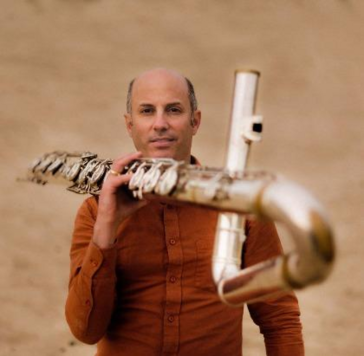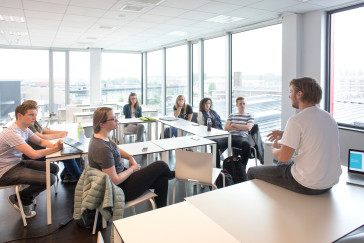A methodology for doing research into corporate spirituality should enable us to deal with the religious component of spirituality instead of trying to separate spirituality from religious beliefs, as the positivist school proposes. Waaijman’s phenomenological-dialogical research cycle enables us to deal with religious diversity in a scientific way. Sölle’s concept of democratized spirituality allows for discovering everyday (corporate) life as a finding place and workplace for spirituality. Replacing theistic terms by the concept of ‘alterity’ in a definition of spirituality may stimulate corporate spirituality without excluding or disqualifying spiritual diversity. Arendt’s concept of ‘action’ is closely connected to democratised spirituality. From that we can deduce a number of characteristics of corporate spirituality that give flesh and bone to what corporate spirituality can be. This allows us to see that many elements of corporate spirituality are already present in our organizational praxis. It also tells us that we need to become more aware of them and practice them. In doing so we set out on a ‘via transformativa’ that eventually may transform our organizations.

This is a print publication of the inaugural lecture of Research Professor (Lector) Patricia de Vries at the Gerrit Rietveld Academie, in Amsterdam. In this lecture, she elaborated on the research area of her research group Art & Spatial Praxis. The research group Art & Spatial Praxis focuses on artistic practices that broaden our imaginations of alternative social orders and ways of living within capitalist city structures.The thematic focus of Art & Spatial Praxis builds on Sylvia Wynter’s rich notion of the plot. With her conception of the plot, Wynter connects the historical enclosures of the plantation to today’s cityscapes. The plot stands for other possibilities that are always present. It represents possibilities rooted in different values and different social orders. This is to say, cityscapes and public spaces are relational, contingent and always contested. The plot challenges the forces of domination, appropriation, exploitation, commodification, gentrification, segregation, digitization, and quantification.What if plot work is a praxis that is socially enacted, embodied, narrativised, and materialised in art practices? What could the plot as artistic praxis be(come)? What constitutes it? What conditions and sustains it? What kind of behaviour, ways of seeing, knowing, and relating does it encourage? In short: what does the plot mean as a spatial art praxis in today’s cityscapes? These are some of the questions the research group Art & Spatial Praxis engages with. These are also pressing questions in the increasingly regulated, privatized, surveilled, and diminished public spaces in ever-more neoliberal cities.Over the years, De Vries has written on a range of topics – be it on fungal co-existence or facial recognition technology: the relationship between society, art, design and research is always the connecting thread.
MULTIFILE
Ik wil vandaag vooral ingaan op de vraag hoe gedrag als object van studie gedefinieerd kan worden en hoe daar onderzoek naar gedaan kan worden. Aan de orde komen achtereenvolgens de psychologische, pedagogische, epistemologische en professionele plaatsbepaling van het lectoraat, dat als opdracht heeft om praktijkgericht onderzoek uit te voeren naar gedrag in de educatieve praxis. Die opdracht zal ik verbinden met de noodzaak om onderzoek naar gedrag van leerlingen en leraren te verbinden met onderzoek met en door leerlingen en leraren (c.q. studenten).

Students in Higher Music Education (HME) are not facilitated to develop both their artistic and academic musical competences. Conservatoires (professional education, or ‘HBO’) traditionally foster the development of musical craftsmanship, while university musicology departments (academic education, or ‘WO’) promote broader perspectives on music’s place in society. All the while, music professionals are increasingly required to combine musical and scholarly knowledge. Indeed, musicianship is more than performance, and musicology more than reflection—a robust musical practice requires people who are versed in both domains. It’s time our education mirrors this blended profession. This proposal entails collaborative projects between a conservatory and a university in two cities where musical performance and musicology equally thrive: Amsterdam (Conservatory and University of Amsterdam) and Utrecht (HKU Utrechts Conservatorium and Utrecht University). Each project will pilot a joint program of study, combining existing modules with newly developed ones. The feasibility of joint degrees will be explored: a combined bachelor’s degree in Amsterdam; and a combined master’s degree in Utrecht. The full innovation process will be translated to a transferable infrastructural model. For 125 students it will fuse praxis-based musical knowledge and skills, practice-led research and academic training. Beyond this, the partners will also use the Comenius funds as a springboard for collaboration between the two cities to enrich their respective BA and MA programs. In the end, the programme will diversify the educational possibilities for students of music in the Netherlands, and thereby increase their professional opportunities in today’s job market.

Voor veel kinderen met een (ernstige en/of meervoudige) beperking is het niet eenvoudig om aan hun omgeving duidelijk te maken hoe ze zich voelen en wat ze zouden willen of nodig hebben. Ouders begrijpen de signalen van hun kinderen vaak als geen ander, maar zouden nog meer met hun kind willen communiceren. ln het project 'Praten kan ik niet..., maar communiceren wil ik wel!' is veel onderzoek gedaan naar de communicatieve ontwikkeling en het effect van het ondersteunen van de communicatie van kinderen met een beperking. Het blijkt dat er grote winst te halen valt door het inzetten van verschillende strategieën, technieken en communicatiehulpmiddelen. Te denken valt aan het inzetten van (vierhanden)gebaren, foto's, pictogrammen, film, voorwerpen, spraakknoppen of - computers en/of tablets, maar ook aan muziek, ritme, (samen) bewegen en inspelen op ervaringen. Helaas merken we in de praktijk dat ouders en therapeuten vaak niet (volledig) op de hoogte zijn van wat er allemaal mogelijk is of hoe het in te zetten bij hun kind. Daarnaast is er voor gezinnen én voor therapeuten vaak weinig tijd om hier actief aan te werken. Voor ouders die de behoefte hebben om hun kind nóg beter te kunnen begrijpen en de communicatiemogelijkheden uit te willen breiden, is tijdens het project 'Praten kan ik niet..., maar communiceren wil ik wel' vanuit de Fontys Paramedische Hogeschool in samenwerking met Stichting Wigwam in 2014 gestart met de organisatie van unieke communicatieweekenden. Dat deze communicatieweekenden voldoen aan vragen en de behoefte van ouders blijkt wel uit de evaluatie ervan en de vraag vanuit meerdere ouderverenigingen, maar ook vanuit therapeuten, om deze communicatieweekenden te blijven organiseren. Om deze weekenden te kunnen organiseren is met name geld nodig om de locaties te huren. De locaties moeten immers geschikt zijn voor overnachting en activiteitenprogramma's voor gezinnen met kinderen met beperkingen. De hogeschool en de in het project deelnemende partners beschikken niet over gebruiksrecht van een dusdanige locatie. Kosten die ouders in rekening kunnen brengen bij de zorgverzekeraar vallen buiten de begroting van deze weekenden. Er is dus sprake van een tegemoetkoming in de overige verblijfkosten. Zonder deze tegemoetkoming zouden de kosten op basis van hun financiële draagkracht voor sommige ouders te hoog zijn, waardoor zij niet zouden kunnen participeren. De subsidie biedt mogelijkheid om geïnteresseerde ouders te laten participeren. Door het organiseren van deze gesubsidieerde weekenden hopen wij voldoende basis te creëren op grond waarvan wij in de toekomst andere sponsoren bereid zullen vinden de accommodatiekosten voor hun rekening te nemen, ten einde een duurzame organisatie op te zetten. Weekenden worden georganiseerd met eigen bijdragen van verschillende partijen. Fontys medewerkers zullen de helft van hun uren als vrijwilliger werken (cofinanciering). Studenten zullen als vrijwilliger participeren. Daarnaast zullen de gezinnen betalen voor hun eigen verblijfs- en cateringkosten. Zo hanteert Stichting Wigwam een gereduceerd tarief. Deelnemende partijen hebben geen winstoogmerk.
Dit project is een voortzetting van het in november ’21 afgeronde Comenius-project ‘Het Narratief zelfportret’ als educatief model voor verdieping van persoonsvorming in een (ped)agogische opleiding’. Het resultaat was een interactieve elektronische leeromgeving op Canvas, waarmee studenten individueel en als leerteam hun Narratief Zelfportret kunnen aanvullen met verschillende perspectieven.
